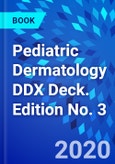Highly visual and uniquely convenient, Pediatric Dermatology DDX Deck, 3rd Edition, Is the quickest, easiest way to compare and contrast 164 of the most common pediatric dermatologic diagnoses. Each card in this swatch-style deck includes full-color images and information about a particular diagnosis, as well as cross-references (DDx refs) to other potential diagnoses. Designed with the busy practitioner in mind, it's the perfect pocket-sized reference for front-line pediatric dermatologic diagnosis.
- Compare potential diagnoses visually, side by side, with more than 600 full-color clinical images - no more flipping back and forth between different diagnostic possibilities.
- Concise descriptions of clinical features and treatment for each condition, as well as clear cross-references to other possible diagnoses.
- New topics include mycoplasma mucositis, acute eruptive generalized pustulosis (AGEP), periarteritis nodosa, mosaic hypopigmentation, Waardenburg's syndrome, congenital atrichia with papules, and more.�
- New coverage of biologics throughout, plus new content on erythema toxicum. � Arranged according to skin appearance, helping you find the most relevant condition more quickly.
- An ideal, pocket-sized guide to diagnosis of children of all ages, including newborns.
Table of Contents
SECTION 1: BLISTERS (VESICLES AND BULLAE)1�Herpes simplex infections
2�Varicella and herpes zoster
3�Hand, foot, and mouth disease
4�Impetigo and ecthyma
5�Staphylococcal scalded skin syndrome (SSSS)
6�Linear IgA dermatosis
7�Dermatitis herpetiformis (DH)
8�Pemphigus
9�Pemphigoid
10�Epidermolysis bullosa, non-scarring
11�Epidermolysis bullosa, scarring
12�Epidermolytic ichthyosis
13�Incontinentia pigmenti
14�Diffuse cutaneous mastocytosis
15�Sucking blisters
16�Miliaria
17�Bullous drug reactions
SECTION 2: MUCOSAL EROSIONS (BLISTER BASES)
18�Aphthous ulcers
19�Geographic tongue
20�Stevens-Johnson syndrome (SJS) and toxic epidermal necrolysis (TEN)
21�Mycoplasma-induced rash and mucositis (MIRM)
22�Mucosal erosions in immunobullous and hereditary bullous diseases
SECTION 3: PUSTULAR LESIONS
23�Erythema toxicum and transient neonatal pustular melanosis
24�Infantile acropustulosis
25�Folliculitis
26�Acne and periorificial dermatitis
27�Pyoderma gangrenosum
28�Acute generalized exanthematous pustulosis (AGEP)
SECTION 4: RED PAPULES AND NODULES
29�Furunculosis and cellulitis
30�Necrotizing fasciitis
31�Mycobacterial infections
32�Viral exanthems
33�Gianotti-Crosti syndrome
34�Scarlet fever
35�Kawasaki disease
36�DRESS syndrome
37�Cutaneous larva migrans
38�Papular urticaria and spider bites
39�Scabies
40�Syphilis
41�Erythema multiforme (EM)
42�Fixed drug eruptions
43�Morbilliform and urticarial drug eruptions
44�Erythema nodosum (EN)
45�Panniculitis
46�Dermatofibromas
47�Keloids and hypertrophic scars
48�Angiofibromas
49�Congenital self-healing reticulohistiocytosis (CSHR)
50�Malignant tumors
SECTION 5: FLAT VASCULAR LESIONS, BLANCHING
51�Mottling
52�Cutis marmorata telangiectasia congenita (CMTC)
53�Livedo reticularis
54�Urticaria and dermographism
55�Port-wine stains and nevus simplex
56�Vascular spiders
57�Neonatal lupus erythematosus
SECTION 6: RAISED BLANCHING VASCULAR LESIONS
58�Hemangiomas
59�Diffuse neonatal hemangiomatosis
60�Tufted angiomas
61�Hemangioendothelioma
62�Pyogenic granuloma
63�Lymphatic malformations
64�Venous malformations
SECTION 7: NON-BLANCHING VASCULAR LESIONS (PETECHIAE AND PURPURA)
65�Vasculitis (Henoch-Sch�nlein purpura)
66�Periarteritis nodosa
67�Pernio
68�Progressive pigmented purpura (PPP)
SECTION 8: PAPULOSQUAMOUS ERUPTIONS
69�Pityriasis rosea (PR)
70�Psoriasis
71�Pityriasis lichenoides
72�Lichen planus (LP) and lichen nitidus
73�Pityriasis rubra pilaris (PRP)
74�Lichen striatus
75�Porokeratosis of Mibelli
76�Lupus erythematosus (LE)
77�Dermatomyositis
78�Ichthyosis
79�Darier's disease (keratosis follicularis)
80�Tinea (dermatophyte infections)
SECTION 9: ECZEMATOUS DISORDERS (RED WITH DISRUPTION OF SKIN SURFACE)
81�Atopic dermatitis (AD)
82�Allergic contact dermatitis (ACD)
83�Juvenile plantar dermatosis
84�Nummular dermatitis
85�Seborrheic dermatitis
86�Langerhans cell histiocytosis (LCH)
87�Diaper dermatitis
88�Intertrigo
89�Candidiasis
90�Perianal cellulitis
91�Acrodermatitis enteropathica (AE)
SECTION 10: SKIN-COLORED PAPULES AND NODULES WITH A ROUGH SURFACE
92�Warts
93�Epidermal nevi
94�Keratosis pilaris (KP)
95�Corns and calluses
SECTION 11: SKIN-COLORED PAPULES AND NODULES WITH A SMOOTH SURFACE
96�Molluscum contagiosum
97�Milia and sebaceous hyperplasia
98�Epidermal cysts
99�Dermoid cysts
100�Pilomatricoma and trichoepithelioma
101�Granuloma annulare
102�Neurofibroma and lipomas
103�Piezogenic papules
104�Sweat gland tumors
SECTION 12: WHITE LESIONS
105�Post-inflammatory hypopigmentation and pityriasis alba
106�Vitiligo
107�Lichen sclerosus (LS)
108�Morphea
109�Halo nevus
110�Nevus depigmentosus and linear and whorled nevoid hypomelanosis (LWNH-Blaschkoid hypomelanosis-hypomelanosis of Ito)
111�Nevus anemicus
112�Ash leaf macules
113�Piebaldism
114�Waardenburg syndrome (WS)
115�Oculocutaneous albinism (OCA)
116�Tinea versicolor
SECTION 13: FLAT BROWN LESIONS
117�Mongolian spots
118�Nevus of Ota
119�Caf�-au-lait macules (CALMs)
120�Freckles
121�Lentigines
122�Nevus spilus
123�Junctional nevi
124�Becker's nevus
125�Post-inflammatory hyperpigmentation
126�Mosaic hyperpigmentation
SECTION 14: RAISED BROWN LESIONS
127�Congenital melanocytic nevi (CMN)
128�Intradermal melanocytic nevi
129�Melanoma
130�Pilar and smooth muscle hamartomas
131�Mastocytosis
132�Benign cephalic histiocytosis
133�Acanthosis nigricans (AN)
134�Confluent and reticulated papillomatosis (CARP)
SECTION 15: YELLOW LESIONS
135�Nevus sebaceus
136�Juvenile xanthogranuloma (JXG)
137�Necrobiosis lipoidica diabeticorum (NLD)
138�Focal dermal hypoplasia
SECTION 16: CONGENITAL CIRCUMSCRIBED HAIR LOSS
139�Aplasia cutis congenita (ACC)
140�Congenital triangular alopecia
SECTION 17: ACQUIRED CIRCUMSCRIBED HAIR LOSS
141�Alopecia areata (AA)
142�Tinea capitis and kerion
143�Traction alopecia and hair pulling
SECTION 18: CONGENITAL DIFFUSE HAIR LOSS
144�Ectodermal dysplasias (ED)
145�Hair shaft defects
146�Congenital atrichia with papules
SECTION 19: ACQUIRED DIFFUSE HAIR LOSS
147�Telogen and anagen effluvium
SECTION 20: THICKENED NAILS
148�Congenital malalignment of the great toe
149�Pachyonychia congenita (PC)
150�Ectodermal dysplasia (nails)
151�Median nail dystrophy
152�Trachyonychia (20 nail dystrophy)
153�Psoriasis nails
154�Lichen planus nails
SECTION 21: THIN, SLOW-GROWING, OR LOSS OF NAIL
155�Ectodermal dysplasia and nail-patella syndrome
SECTION 22: PITTED LESIONS
156�Ear pits and lip pits
157�Pitted keratolysis
SECTION 23: INVOLVEMENT OF PALMS AND SOLES
158�Palmoplantar keratodermas (PPK)
SECTION 24: PHOTODISTRIBUTION (SUN-INDUCED LESIONS)
159�Sunburn
160�Phytophotodermatitis
161�Polymorphous light eruption (PMLE)
162�Erythropoietic protoporphyria (EPP)
SECTION 25: ANNULAR ARRANGEMENTS
163�Annular arrangement
SECTION 26: LINEAR OR CURVILINEAR ARRANGEMENTS
164�Linear or curvilinear arrangement
INDEX








